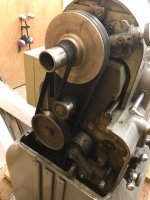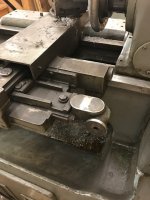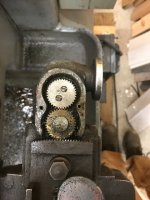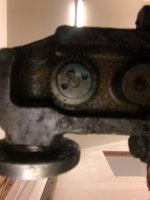Ummh.. well.. as with that 'very special' pig with the wooden leg, you don't have to 'eat' nor read this 'all at once'. Nor at all, actually..

Monarch was 'customer', Reliance Electric and Engineering was 'designer' to their needs.
Hard to tell from a distance which of them decided what to call stuff, but the 'exciter' is a DC generator and CALLED 'exciter' because its output power is used to 'excite' the FIELD on both the final-drive motor and what I have called the 'primary' DC generator. it also powers the contactors AND ta da... provides its OWN excitation power.
*I* call the 'other' DC generator the 'primary' so I do not forget which one is on first base. Monarch/Reliance just called it 'the' DC generator. More usefully, it drives the Armature of the final-drive motor, nothing else EXCEPT that some 'sensitive' control relays 'look at' its Voltage to determine how - and when - they should behave.
Now the reason for what might seem like monkey-motion.. is that the stronger the field on a DC shunt wound motor, the more torque it has. Stronger electromagnetic field is functionally similar to deeper 'notches' to grab aholt of if it were a ratchet.
Weakening the field reduces the 'grab' as if notches were shallower. Result is sort of like gradually turning a staircase with big, notchy treads into a flatter and flatter ramp. Person can run faster up a ramp because yah don't have to swing yer feet up out of the deep pockets a set of stairs represent.
One dasn't expect to have as good a grip on a ramp as on a staircase, and of course the 10EE does NOT have as much (reserve) torque when high-up in the Field weakened range, so it is for smaller diameters, lighter cuts, even polishing operations.
On DC elevators, f'rinstance, the weakened Field range might be used for rapid positioning of an EMPTY lift cabin to get it to the floor where waiting passengers had pressed a 'Call' button. What with the counterweights and no mass of passengers, not as much energy was required.
Same again in reverse with generators instead of motors.
The stronger the Field on a
DC generator, the tighter the grip it has on whatever is turning its input shaft. Tighter that grip, the greater the amount of power it can grab and convert from mechanical force to output as greater current and voltage.
So... altering Field power on either a motor or generator has a multiplier effect. We can use that for a form of 'amplification', where small control inputs produce great changes in output.
Leverage, if you will.
The nominal 3 HP large frame Reliance final-drive motor has a 230 VDC Armature at a Full Load Amp rating around 12 Amps. That's 2,760 Volt-Amps or 2.7 KVA.
Worse, Monarch/Reliance 'hot rodded' that motor's Armature Voltage above 'nameplate' to improve reserve when in Field-Weakened range.
PM members have put meters on them and found 250 VDC, 255 VDC, even 260 VDC as not unusual. Higher the voltage, the greater the current flow, the higher the VA or KVA.
I rate it as much as a 4.6 HP motor, not a 3 HP, before it starts to get to where it might do harm to itself. The MG's 'primary' DC generator is 'matched' to the need, cannot push it into the danger zone, so no risk of harm.
A third-party solid-state DC drive certainly CAN push it there, which is how and why I know and care.
If the Reliance Engineer who designed that motor was looking down from on-high, he might have a big SE grin on his face and say:
Now . .let's back into what sort of Wattage rating a variable resistor would need to have to DIRECTLY control that power.
Any energy it wants to deny to the motor for use as rotating power must be shed some other way.
As HEAT.
In order to have a reasonable reserve, we'd have to start with resistors rated for somewhere between three and five THOUSAND Watts. We'd need forced-air or even pumped-liquid cooling to make that work at even unreasonably large sizes. Worse - we'd be adding to a factory electrical bill times a whole row of lathes, up to three shifts a day. Bad enough as it is. A 10EE MG wastes close to fifty percent of what it takes out of the wall. An SSD solid-state DC drive wastes mebbe five percent, doesn't even want a
tiny cooling fan.
Back to the 'leverage' of controlling the FIELD instead:
- by altering Field strength on what I have called the 'primary' DC generator, we simply have it produce higher or lower power at its output. That gives the final-drive motor a varying ration with NO extra waste as heat
in its own circuit. The 'heavy' one.
The Field circuit at the other end of that 'leverage' operates with only 115 DC at 1.3 to 2 or so Amps. Now our resistor/rheostat has to dissipate only a portion of 150 to 200 Watts, worst-case. And they are not run at 'worst case' anyway.
Thats's still a rather stout resistor. The Ohmites in an MG-era 10EE are big bastards.
But only ten or twenty percent the size and waste heat they would need to be if used 'directly'.
And ... it is also important that they DO waste less. That's what a Ward-Leonard system is all about.
Durable and
affordable leverage with simple components.
Not impossible there are Ward-Leonard systems on hoists and lifts more than a hundred years in service somewhere.
WiaD and Modular drives add the GREATER 'leverage' or amplification of hollow-state, AKA 'vacuum' tubes. They can get the waste in their controls down to under 50 Watts and still have about 100% safety reserve.
Solid-state DC Drives use "operational amplifiers" for so much amplification they must be strapped-down, and get by with TWO Watt or less control potentiometers.
However .. you just ain't gonna see that hundred-year simple maintenance lifespan with the more fragile Vee Eff Dee and its capacitor bank, nor even the far simpler and more rugged no-big-caps-atall SCR/Thyristor drives.
If nothing else, their fragile
control electronics tend to get zapped every now and then by a 'near-miss' lightning strike a mile or three down the grid...
Or.. as close as my fat-fingering a direct short onto an SSD 507 in use as Field supply at a couple of Amps, six Amp max, and blowing the Silicon brains out of the 16 A SSD 514C a few inches away... on the same AC line.
If you want to make chips, not scratch yerself bald-headed nor pay invoices to electronics houses, there is a lot to be said for simpler MG power.














